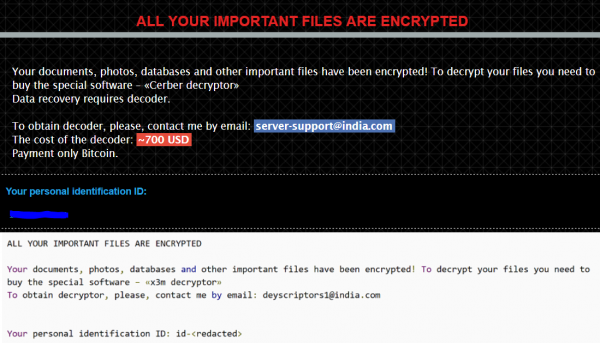x3m ransomware owes its name to its encrypting data with the above crypto algorithm, yet adds the same at the end of the files affected. The infection splits data to be encrypted and processes the resulting items on a case-by-case basis. That is to say, each micro-piece of data has all its bits badly modified, yet with a unique key. That is why the crooks may offer a test decryption without risking the test tool to be further used by the victims for ransom-free decryption of the remaining files.

The files scrambled by the rogue get their names modified. x3m is the extra suffix that follows the native extension. This indicates the file is blocked. Meanwhile, the ransomware creates its general note titled: ALL YOUR IMPORTANT FILES ARE ENCRYPTED. This may also be set a desktop background. Some versions of the x3m encryption virus create the ransom message file in the each folder that contains encrypted data.
The general ransom note basically says the only way to get rid of x3m ransomware encryption is by way of contacting the attackers. Its statement that any attempts to decode the data with free decryption tool may destroy the files hints at the paid decryption to be purchased by the victims. In particular, the infection instructs its victims to contact them with an email sent to [email protected]. Optionally, the users may opt for negotiating the ransom in BitMessage application. The ransom note thus contains relevant contact for the victim, as well as the victim’s unique code so that the crooks could recognize the requesting party at once.
The ransom demanded by the virus varies. It is to be paid in bitcoins. Some victims have expressed their concern as they could not purchase a sufficient amount of bitcoins. A single bitcoin currently amounts to over $900 and keeps on growing pretty fast. Odds are that the rate of exchange to USD will soon exceed $1000. That is to say, even the amount of 0.5 bitcoins typically demanded by the cyber criminals is rather significant. This very ransomware demands roughly $700.
True, there are no free descriptors available so far. However, you should not whenever possible, pay any amounts to the crooks. Consider the recovery options below. Please also note the cyber security may release free decryptor in future. Therefore, it is good to copy your encrypted data into isolated media so that you could decrypt it, in case IT security releases free decryption tool.
Automatic removal of x3m ransomware
The benefits of using the automatic security suite to get rid of this infection are obvious: it scans the entire system and detects all potential fragments of the virus, so you are a few mouse clicks away from a complete fix.
- Download and install recommended malware security suite
- Select Start Computer Scan feature and wait until the utility comes up with the scan report. Proceed by clicking on the Fix Threats button, which will trigger a thorough removal process to address all the malware issues compromising your computer and your privacy.
Restore files locked by x3m virus
x3m virus represents a unique category of malicious software whose attack surface reaches beyond the operating system and its components, which is why removing the virus itself is a part of the fix only. As it has been mentioned, it encrypts one’s personal information, so the next phase of the overall remediation presupposes reinstating the files that will otherwise remain inaccessible.
-
Launch data recovery software
Similarly to the rest of its fellow-infections, x3m most likely follows an operational algorithm where it erases the original versions of the victim’s files and actually encrypts their copies. This peculiarity might make your day, because forensics-focused applications like Data Recovery Pro are capable of restoring the information that has been removed. As the virus further evolves, its modus operandi may be altered – in the meanwhile, go ahead and try this.
-
Take advantage of Volume Shadow Copy Service
This technique is based on using the native backup functionality that’s shipped with Windows operating system. Also referred to as Volume Snapshot Service (VSS), this feature makes regular backups of the user’s files and keeps their most recent versions as long as System Restore is on. x3m virus hasn’t been found to affect these copies therefore the restoration vector in question is strongly recommended. The two sub-sections below highlight the automatic and manual workflow.
- a) Use Shadow Explorer
Shadow Explorer is an applet that provides an easy way of retrieving previous versions of files and folders. Its pro’s include an intuitive interface where the computer’s entire file hierarchy is displayed within one window. Just pick the hard disk volume, select the object or directory to be restored, right-click on it and choose Export. Follow the app’s prompts to get the job done.

- b) Use file properties
Essentially, what the above-mentioned Shadow Explorer tool does is it automates the process that can otherwise be performed manually via the Properties dialog for individual files. This particular approach is more cumbrous but just as effective as its software-based counterpart, so you can proceed by right-clicking on a specific file, which has been encrypted by x3m ransomware, and selecting Properties in the context menu. The tab named Previous Versions is the next thing to click – it displays available versions of the file by date of the snapshot creation. Pick the latest copy and complete the retrieval by following the prompts.

-
Data backups work wonders
Ransomware like x3m isn’t nearly as almighty and destructive in case you run regular file backups to the cloud or external data media. The virus itself can be completely removed in a matter of minutes, and the distorted information can then be just as easily recovered from the backup. Luckily, this is a growing trend, so ransom Trojans are hopefully going to become less subversive in the near future.
Verify thoroughness of the removal
Having carried out the instructions above, add a finishing touch to the security procedure by running an additional computer scan to check for residual malware activity
